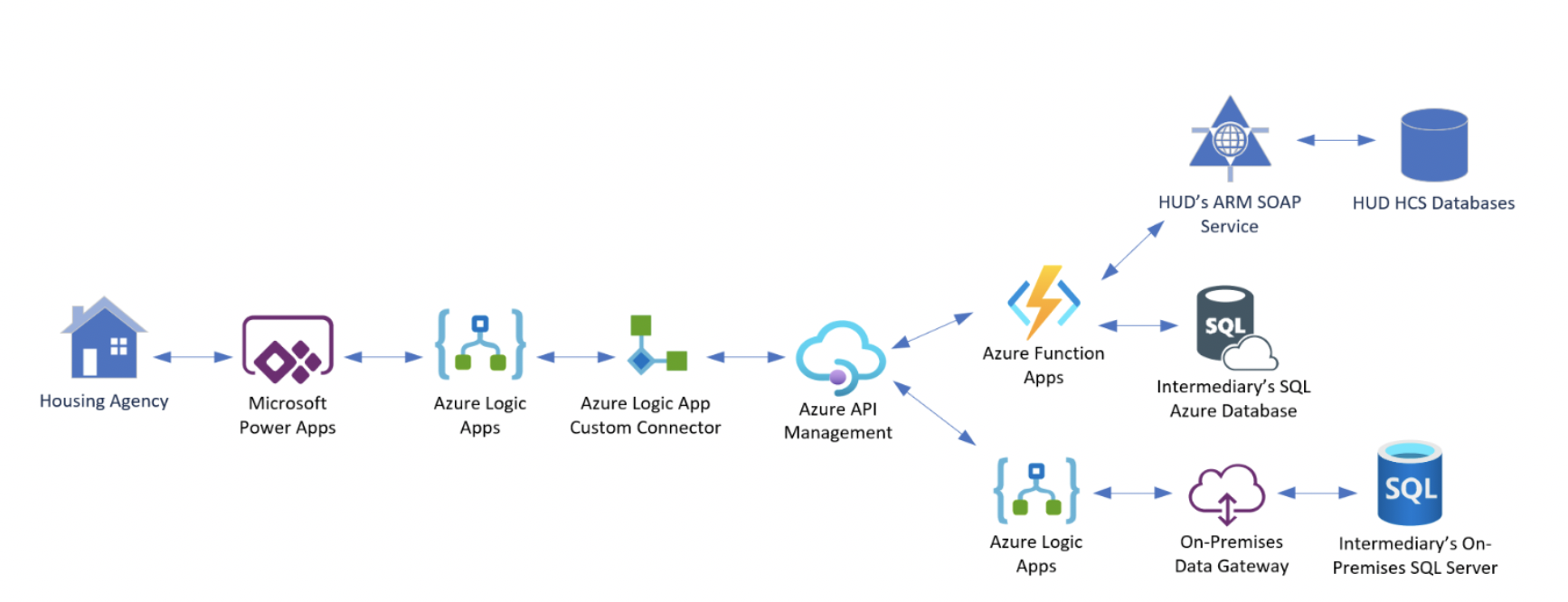Leveraging the Power Platform and Microsoft Azure to connect housing agencies and intermediaries with the Department of Housing and Urban Development (HUD)
Intro
The US Department of Housing and Urban Development runs a program known as the Housing Counseling Program that aids housing agencies around the nation through things like grants and training. These agencies provide tremendous benefit to Americans in many forms including credit counseling, foreclosure prevention, predatory lending awareness, homelessness, and more. One of the requirements for approval into the program is that the agency uses a software system that is also approved by HUD and interfaces with HUD’s Agency Reporting Module SOAP web service.
Original System
The original system is built on Dynamics 365 Online using custom entities, web resources, and plug-ins. Complex batching functionality was implemented to deal with the two-minute timeout period that plug-ins have, web resource files (JavaScript, HTML, and CSS) were stuck in a solution with no real structure, and application lifecycle management (ALM) was extremely painful. The original system design also doesn’t account for the intermediary-to-agency relationship, specifically the roll-up reporting and auditing that intermediaries desperately need for providing their compiled agency data to HUD, as well as their own internal reporting. Finally, because the solution was built using Dynamics 365 Online Customer Engagement, licensing costs were more than double what we knew they could be with Microsoft’s new Power Apps licenses and Azure pay-as-you-go subscriptions.
Figure 1 – current CMS system build on Dynamics 365 Online
Definition
Intermediaries – organizations that operate a network of housing counseling agencies, providing critical support services to said agencies including training, pass-through funding, and technical assistance.
Modern System
Whereas the data schema for the solution remains mostly unchanged, the architecture of the system has changed profoundly. Let’s check out some of the bigger changes.
Power Apps Component Framework (PCF)
The Power Apps Component Framework enables developers to create code components that can run on model-driven and canvas apps and can be used on forms, dashboards, and views. Unlike traditional web resources, PCF controls are rendered in the same context and at the same time as any other component on a form. A major draw for developers is that PCF controls are created using TypeScript and tools like Visual Studio, and Visual Studio Code. In the modern solution, web resources are replaced with PCF controls that make calls directly to the Power Apps Web API.
Azure Resources (API Management, Function Apps, Logic Apps, and a Custom Connector)
A Custom Connector and Azure API Management are used to manage and secure various APIs that are used in the system. The connector can be used in any Azure Logic App to make connecting to an API much easier than having to configure HTTP actions. All of the business logic that once lived in plug-ins has been replaced with a combination of Azure Logic Apps and Azure Function Apps. This has provided incredible gains where development and testing are concerned, but it also provides a more secure and scalable model to support these agencies as they grow. Lastly, it removes the burden experienced with the two-minute time-out limitation that plug-ins have.
ALM with Azure DevOps Services and Power Apps Build Tools
Azure DevOps Services, coupled with the Power Apps Build Tools, are being used to ease the pain we experienced with ALM prior to these tools being available. Now we can easily move our Power App solutions across environments (e.g. dev, test, production) and ensure our latest solution code and configurations are always captured in source control.
Figure 2 – modern solution using Power Apps and Azure resources for extreme scalability and maintainability
Next Steps
I hope by demonstrating this use case you’re inspired to contact your Microsoft partner, or better yet contact us and let us work with you to identify your organization’s workloads and technology modernization opportunities.
Ready to dig a little deeper into the technologies used in this blog post? Below we have some hands-on labs for you. Stay tuned for more updates!
- Power Apps Component Framework Controls
As a developer, PCF Controls has been one of the most exciting things to grace the Power Platform landscape. In this video, I’ll show you how to go from zero to a simple PCF control that calls the Power Platform Web API. I also provide a Pro Tip or two on how I organize my PCF controls in my development environment. - Using an Azure Logic App to Query Data in an On-Premises SQL Server Database
Companies are embracing modernization efforts across the organization, quickly replacing legacy apps with Power Apps and Azure resources. This can’t all happen at once though, and often times companies either can’t or won’t move certain data to the cloud. In this hands-on lab, I’ll walk you through using an Azure Logic App and an On-Premises Data Gateway to connect to a local SQL Server 2017 database to query customer data using an HTTP request and response. - Azure API Management and Custom Connectors
API’s give you the ability to better secure and manage your application interfaces. Couple an API with a Custom Connector and you not only better secure and manage, but also make it super easy for other app developers across the organization to connect to your back-end resources through the API, without having to worry about all of the API configurations. - Power Apps DevOps Using Best Practices
There’s more to DevOps than just backing up your Power App solutions in source control and automating your build and release pipeline. Good solution management and best practices around publishers, entity metadata, components, and subcomponents are also key to manageability and scalability with your ALM.








